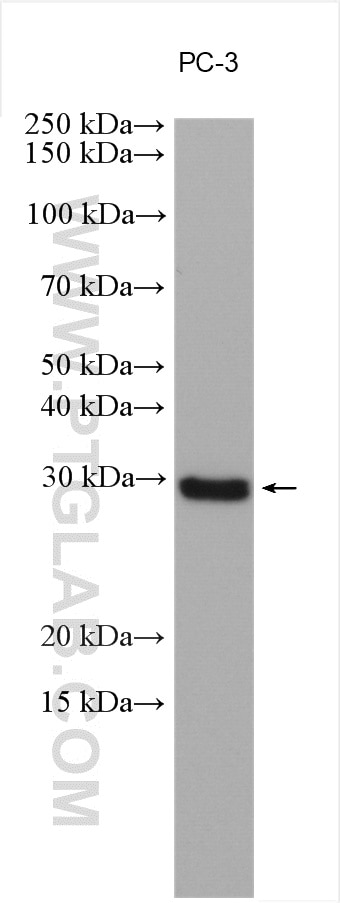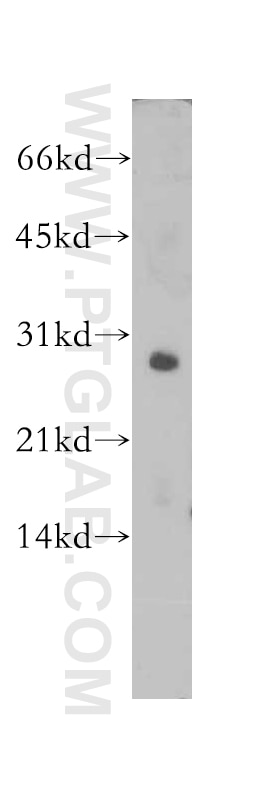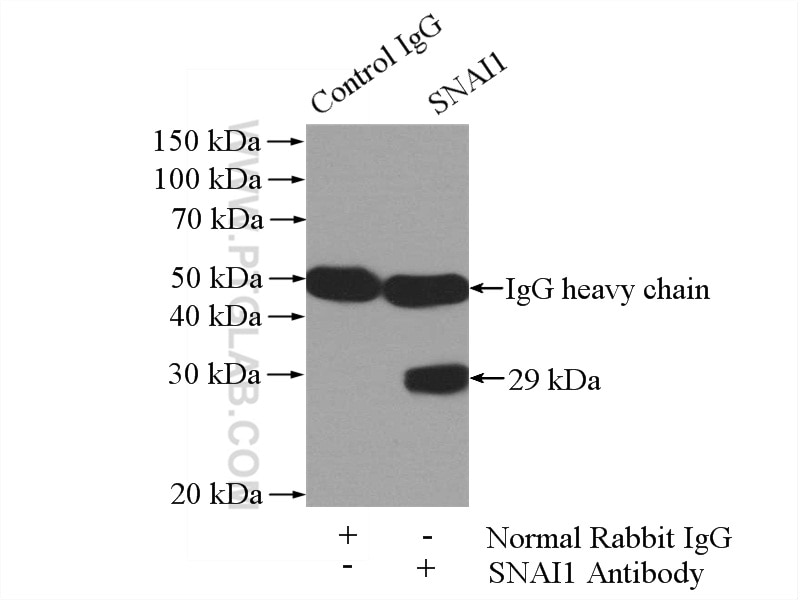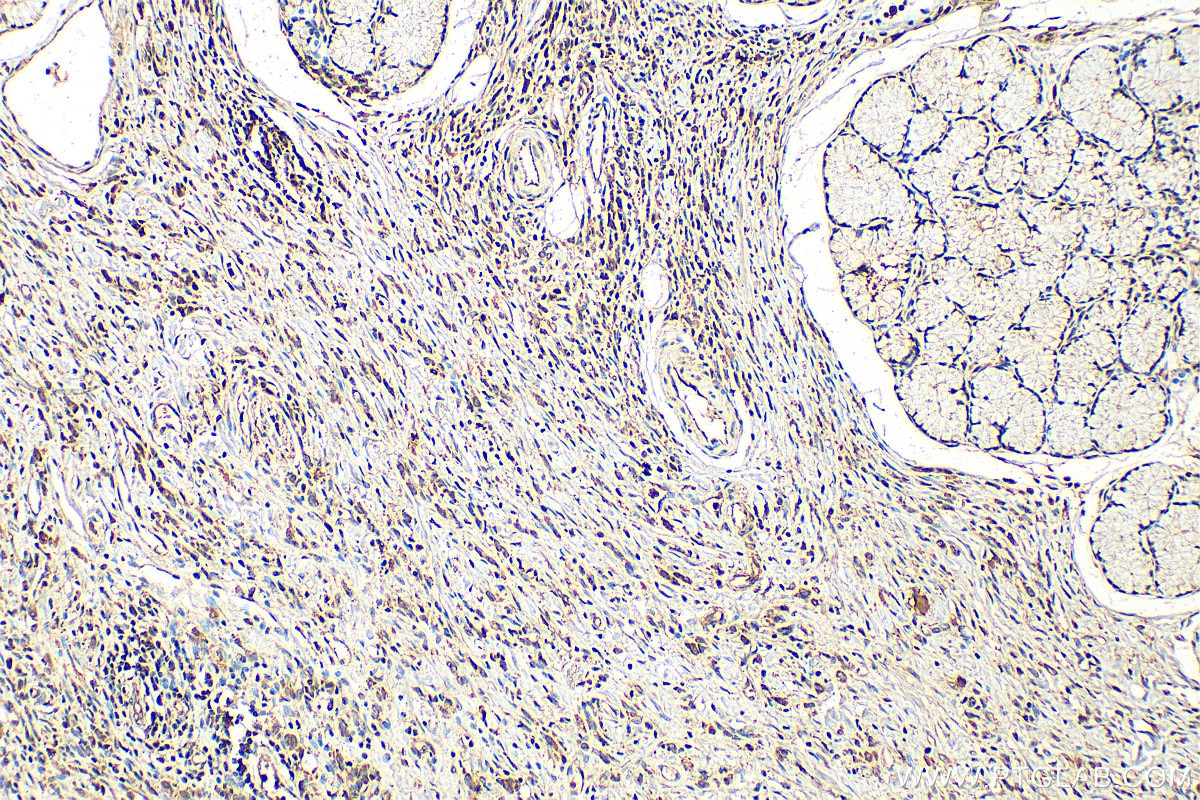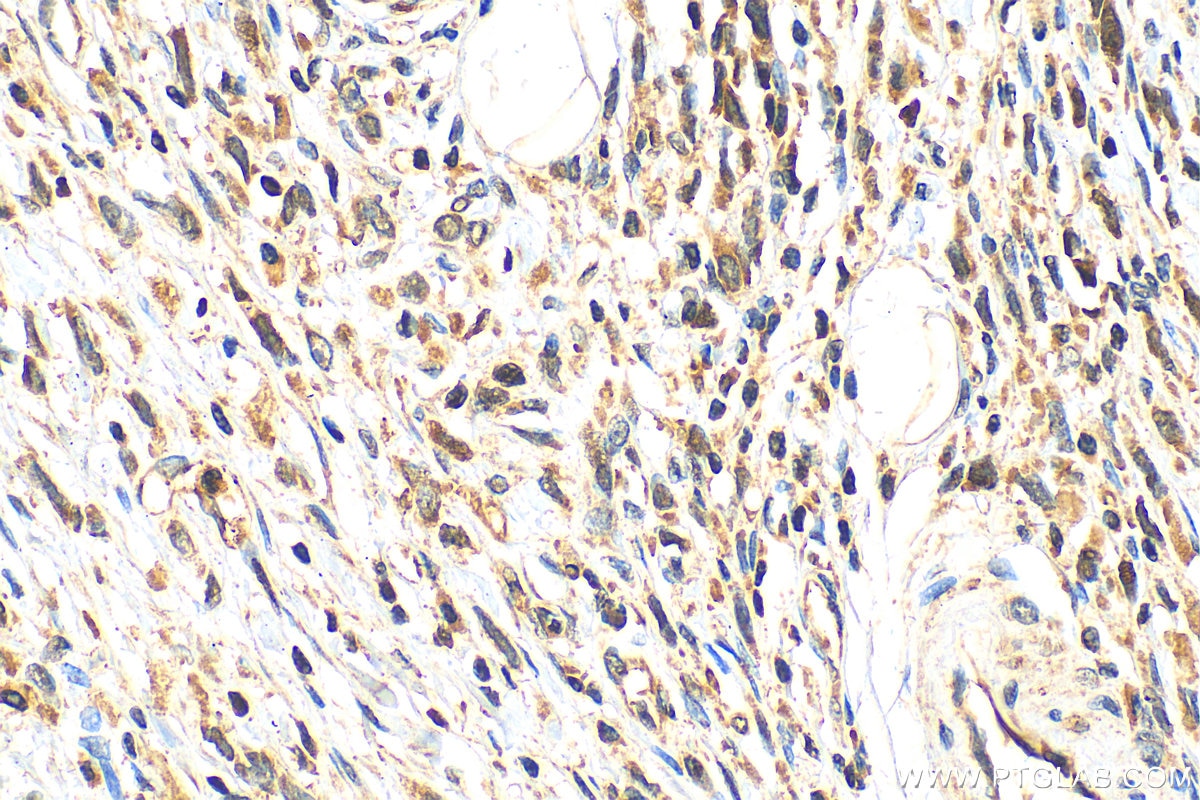- Phare
- Validé par KD/KO
Anticorps Polyclonal de lapin anti-SNAI1
SNAI1 Polyclonal Antibody for WB, IP, IHC, ELISA
Hôte / Isotype
Lapin / IgG
Réactivité testée
Humain, rat, souris et plus (1)
Applications
WB, IHC, IF, IP, CoIP, ChIP, ELISA
Conjugaison
Non conjugué
N° de cat : 13099-1-AP
Synonymes
Galerie de données de validation
Applications testées
| Résultats positifs en WB | tissu cardiaque de souris, cellules BxPC-3, cellules COLO 320, cellules MCF-7, cellules PC-3, tissu cardiaque humain |
| Résultats positifs en IP | cellules MCF-7 |
| Résultats positifs en IHC | tissu de cancer de l'estomac humain, il est suggéré de démasquer l'antigène avec un tampon de TE buffer pH 9.0; (*) À défaut, 'le démasquage de l'antigène peut être 'effectué avec un tampon citrate pH 6,0. |
Dilution recommandée
| Application | Dilution |
|---|---|
| Western Blot (WB) | WB : 1:500-1:1000 |
| Immunoprécipitation (IP) | IP : 0.5-4.0 ug for 1.0-3.0 mg of total protein lysate |
| Immunohistochimie (IHC) | IHC : 1:50-1:500 |
| It is recommended that this reagent should be titrated in each testing system to obtain optimal results. | |
| Sample-dependent, check data in validation data gallery | |
Informations sur le produit
13099-1-AP cible SNAI1 dans les applications de WB, IHC, IF, IP, CoIP, ChIP, ELISA et montre une réactivité avec des échantillons Humain, rat, souris
| Réactivité | Humain, rat, souris |
| Réactivité citée | rat, Chèvre, Humain, souris |
| Hôte / Isotype | Lapin / IgG |
| Clonalité | Polyclonal |
| Type | Anticorps |
| Immunogène | SNAI1 Protéine recombinante Ag3723 |
| Nom complet | snail homolog 1 (Drosophila) |
| Masse moléculaire calculée | 264 aa, 29 kDa |
| Poids moléculaire observé | 29-35 kDa |
| Numéro d’acquisition GenBank | BC012910 |
| Symbole du gène | SNAI1 |
| Identification du gène (NCBI) | 6615 |
| Conjugaison | Non conjugué |
| Forme | Liquide |
| Méthode de purification | Purification par affinité contre l'antigène |
| Tampon de stockage | PBS with 0.02% sodium azide and 50% glycerol |
| Conditions de stockage | Stocker à -20°C. Stable pendant un an après l'expédition. L'aliquotage n'est pas nécessaire pour le stockage à -20oC Les 20ul contiennent 0,1% de BSA. |
Informations générales
SNAI1, a member of SNAI1 family of protein, participates in the epithelial to mesenchymal transition(EMT) and formation and maintenance of embryonic mesoderm. The snail family share a common structural, that a highly conserved C-terminal region containing a zinc finger transcription factor. SNAI1 interacts with other corepressor, such as Ajuba, PRMT5 and SIN3a or HDAC1 and 2, to repress the target gene. As the phosphorylation modification of SNAI1 protein, the range of molecular weight of SNAI1 is about 25-30 kDa (PMID: 22276203 ). Once phosphorylated (probably on Ser-107, Ser-111, Ser-115 and Ser-119) it is exported from the nucleus to the cytoplasm where subsequent phosphorylation of the destruction motif and ubiquitination involving BTRC occurs.
Protocole
| Product Specific Protocols | |
|---|---|
| WB protocol for SNAI1 antibody 13099-1-AP | Download protocol |
| IHC protocol for SNAI1 antibody 13099-1-AP | Download protocol |
| IP protocol for SNAI1 antibody 13099-1-AP | Download protocol |
| Standard Protocols | |
|---|---|
| Click here to view our Standard Protocols |
Publications
| Species | Application | Title |
|---|---|---|
Biomater Res Treatment of bladder cancer by geoinspired synthetic chrysotile nanocarrier-delivered circPRMT5 siRNA. | ||
Theranostics FSH induces EMT in ovarian cancer via ALKBH5-regulated Snail m6A demethylation | ||
Nat Commun Symmetry breaking of tissue mechanics in wound induced hair follicle regeneration of laboratory and spiny mice. | ||
EMBO J SIRT5-mediated desuccinylation of PPA2 enhances HIF-1alpha-dependent adaptation to hypoxic stress and colorectal cancer metastasis | ||
Cancer Res An in vivo CRISPR screen identifies that SNRPC promotes triple-negative breast cancer progression |
Avis
The reviews below have been submitted by verified Proteintech customers who received an incentive for providing their feedback.
FH Angie (Verified Customer) (07-26-2025) | Used at 1:500 dilution and incubated overnight at 4°C. Secondary antibody: Donkey-anti-rabbit (Alexa Fluor 680) at 1:20000 dilution incubated at room temperature for 1 hour.
 |
FH Gisella (Verified Customer) (07-10-2025) | Antibody worked well in canine bladder tissue IHC (FFPE) at dilution of 1:100. Developed almost immediately, so probably could have tried higher dilution.
|
FH Udesh (Verified Customer) (08-16-2023) | Worked well in WB at 1:2000
|
FH Hala (Verified Customer) (11-23-2021) | works very good
|

